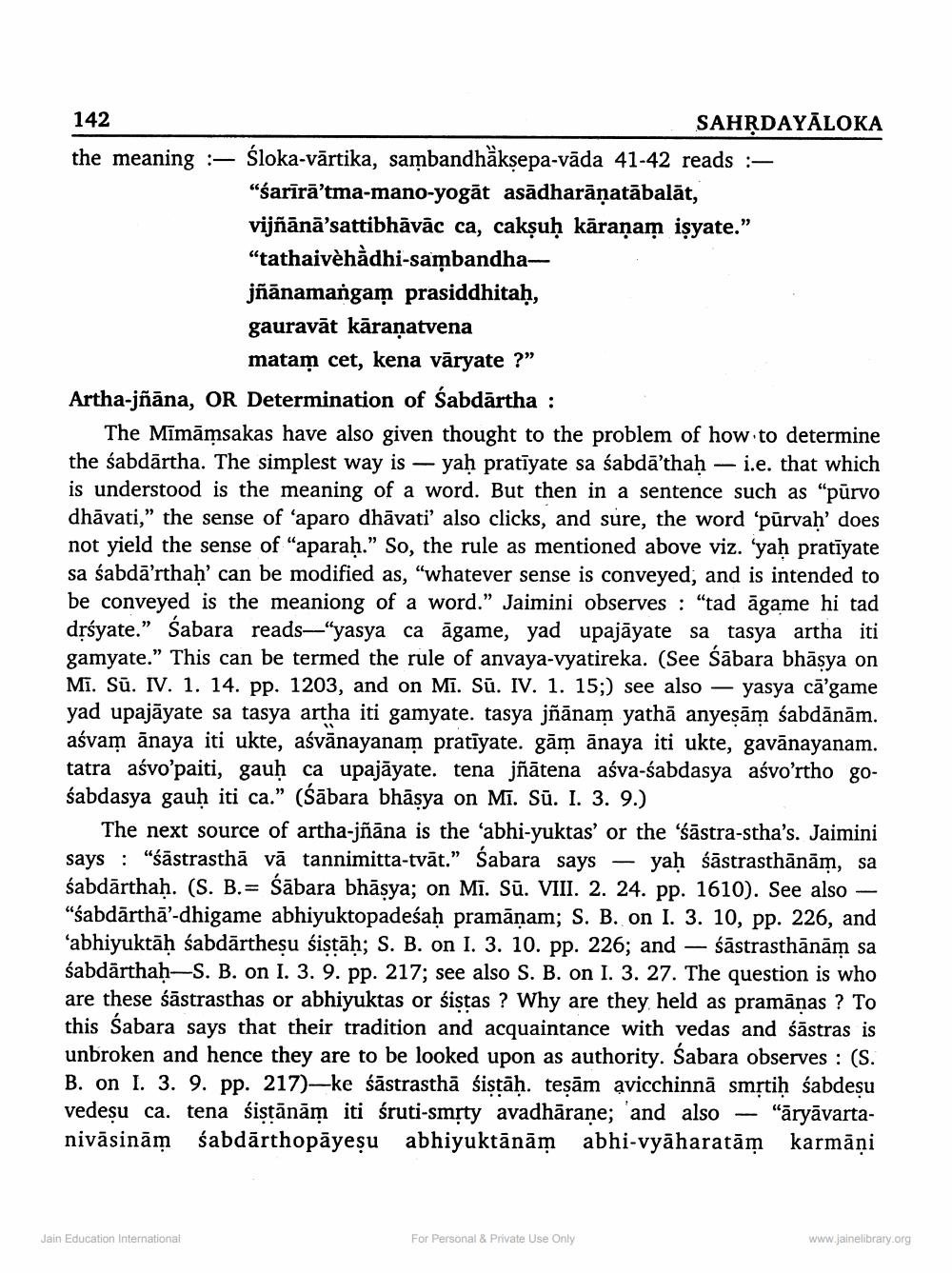________________
142
SAHRDAYĀLOKA the meaning :- śloka-vārtika, sambandhäksepa-vāda 41-42 reads :
"śarīrā’tma-mano-yogāt asādharāņatābalāt, vijñānā'sattibhāvāc ca, cakṣuḥ kāraṇam isyate.” “tathaivèhàdhi-sambandhajñānamangam prasiddhitah, gauravāt kāraṇatvena
matam cet, kena vāryate ?” Artha-jñāna, OR Determination of Sabdārtha :
The Mīmāņsakas have also given thought to the problem of how to determine the śabdārtha. The simplest way is - yah pratīyate sa śabdā'thaḥ - i.e. that which is understood is the meaning of a word. But then in a sentence such as “pūrvo dhāvati," the sense of ‘aparo dhāvati' also clicks, and sure, the word 'pūrvaḥ' does not yield the sense of “aparah.” So, the rule as mentioned above viz. 'yah pratīyate sa sabdā'rthah' can be modified as, "whatever sense is conveyed, and is intended to be conveyed is the meaniong of a word.” Jaimini observes : "tad āgame hi tad drśyate." Sabara reads--"yasya ca āgame, yad upajāyate sa tasya artha iti gamyate.” This can be termed the rule of anvaya-vyatireka. (See Śābara bhāsya on Mi. Sū. IV. 1. 14. pp. 1203, and on Mi. Sū. IV. 1. 15;) see also — yasya cā'game yad upajāyate sa tasya artha iti gamyate. tasya jñānam yathā anyeşām sabdānām. aśvam ānaya iti ukte, aśvānayanam pratīyate. gām ānaya iti ukte, gavānayanam. tatra aśvo’paiti, gauḥ ca upajāyate. tena jñātena aśva-sabdasya aśvo'rtho goabdasya gauḥ iti ca.” (Šābara bhāsya on Mī. Sū. I. 3. 9.)
The next source of artha-jñāna is the ‘abhi-yuktas' or the Šāstra-stha's. Jaimini says: "śāstrasthā vā tannimitta-tvāt.” Sabara says – yah śāstrasthānām, sa śabdārthah. (S. B.= Śābara bhāsya; on Mī. Sū. VIII. 2. 24. pp. 1610). See also — "sabdārthā’-dhigame abhiyuktopadeśaḥ pramāņam; S. B. on I. 3. 10, pp. 226, and ‘abhiyuktāh śabdārthesu śistāh; S. B. on I. 3. 10. pp. 226; and — śāstrasthānām sa śabdārthaḥ-S. B. on I. 3. 9. pp. 217; see also S. B. on I. 3. 27. The question is who are these śāstrasthas or abhiyuktas or śistas ? Why are they held as pramānas ? To this Sabara says that their tradition and acquaintance with vedas and śāstras is unbroken and hence they are to be looked upon as authority. Śabara observes : (S. B. on I. 3. 9. pp. 217)—ke śāstrasthā śistāḥ. teşām avicchinnā smstiḥ śabdesu vedesu ca. tena śistānām iti śruti-smrty avadhārane; and also — "āryāvartanivāsinām śabdārthopāyesu abhiyuktānām abhi-vyā haratām karmāni
Jain Education International
For Personal & Private Use Only
www.jainelibrary.org




